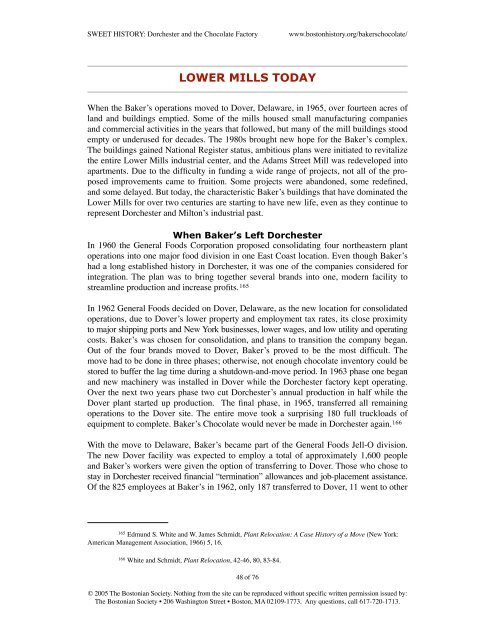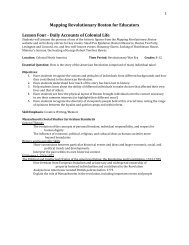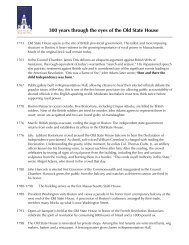Sweet History: Dorchester and the Chocolate ... - Bostonian Society
Sweet History: Dorchester and the Chocolate ... - Bostonian Society
Sweet History: Dorchester and the Chocolate ... - Bostonian Society
You also want an ePaper? Increase the reach of your titles
YUMPU automatically turns print PDFs into web optimized ePapers that Google loves.
SWEET HISTORY: <strong>Dorchester</strong> <strong>and</strong> <strong>the</strong> <strong>Chocolate</strong> Factorywww.bostonhistory.org/bakerschocolate/LOWER MILLS TODAYWhen <strong>the</strong> Baker’s operations moved to Dover, Delaware, in 1965, over fourteen acres ofl<strong>and</strong> <strong>and</strong> buildings emptied. Some of <strong>the</strong> mills housed small manufacturing companies<strong>and</strong> commercial activities in <strong>the</strong> years that followed, but many of <strong>the</strong> mill buildings stoodempty or underused for decades. The 1980s brought new hope for <strong>the</strong> Baker’s complex.The buildings gained National Register status, ambitious plans were initiated to revitalize<strong>the</strong> entire Lower Mills industrial center, <strong>and</strong> <strong>the</strong> Adams Street Mill was redeveloped intoapartments. Due to <strong>the</strong> difficulty in funding a wide range of projects, not all of <strong>the</strong> proposedimprovements came to fruition. Some projects were ab<strong>and</strong>oned, some redefined,<strong>and</strong> some delayed. But today, <strong>the</strong> characteristic Baker’s buildings that have dominated <strong>the</strong>Lower Mills for over two centuries are starting to have new life, even as <strong>the</strong>y continue torepresent <strong>Dorchester</strong> <strong>and</strong> Milton’s industrial past.When Baker’s Left <strong>Dorchester</strong>In 1960 <strong>the</strong> General Foods Corporation proposed consolidating four nor<strong>the</strong>astern plantoperations into one major food division in one East Coast location. Even though Baker’shad a long established history in <strong>Dorchester</strong>, it was one of <strong>the</strong> companies considered forintegration. The plan was to bring toge<strong>the</strong>r several br<strong>and</strong>s into one, modern facility tostreamline production <strong>and</strong> increase profits. 165In 1962 General Foods decided on Dover, Delaware, as <strong>the</strong> new location for consolidatedoperations, due to Dover’s lower property <strong>and</strong> employment tax rates, its close proximityto major shipping ports <strong>and</strong> New York businesses, lower wages, <strong>and</strong> low utility <strong>and</strong> operatingcosts. Baker’s was chosen for consolidation, <strong>and</strong> plans to transition <strong>the</strong> company began.Out of <strong>the</strong> four br<strong>and</strong>s moved to Dover, Baker’s proved to be <strong>the</strong> most difficult. Themove had to be done in three phases; o<strong>the</strong>rwise, not enough chocolate inventory could bestored to buffer <strong>the</strong> lag time during a shutdown-<strong>and</strong>-move period. In 1963 phase one began<strong>and</strong> new machinery was installed in Dover while <strong>the</strong> <strong>Dorchester</strong> factory kept operating.Over <strong>the</strong> next two years phase two cut <strong>Dorchester</strong>’s annual production in half while <strong>the</strong>Dover plant started up production. The final phase, in 1965, transferred all remainingoperations to <strong>the</strong> Dover site. The entire move took a surprising 180 full truckloads ofequipment to complete. Baker’s <strong>Chocolate</strong> would never be made in <strong>Dorchester</strong> again. 166With <strong>the</strong> move to Delaware, Baker’s became part of <strong>the</strong> General Foods Jell-O division.The new Dover facility was expected to employ a total of approximately 1,600 people<strong>and</strong> Baker’s workers were given <strong>the</strong> option of transferring to Dover. Those who chose tostay in <strong>Dorchester</strong> received financial “termination” allowances <strong>and</strong> job-placement assistance.Of <strong>the</strong> 825 employees at Baker’s in 1962, only 187 transferred to Dover, 11 went to o<strong>the</strong>r 165 Edmund S. White <strong>and</strong> W. James Schmidt, Plant Relocation: A Case <strong>History</strong> of a Move (New York:American Management Association, 1966) 5, 16. 166 White <strong>and</strong> Schmidt, Plant Relocation, 42-46, 80, 83-84.48 of 76© 2005 The <strong>Bostonian</strong> <strong>Society</strong>. Nothing from <strong>the</strong> site can be reproduced without specific written permission issued by:The <strong>Bostonian</strong> <strong>Society</strong> • 206 Washington Street • Boston, MA 02109-1773. Any questions, call 617-720-1713.






